The Great Institutional Bitcoin Capitulation
For once, the big financial institutions are late to the game, and it’s beautiful to see.
In the aftermath of the regulatory actions against crypto-native firms like Coinbase and Binance, many investors braced themselves for a significant plunge in Bitcoin’s price. The sentiment swiftly morphed into fear, and it’s not difficult to grasp why this change occurred.
Binance and Coinbase, the world’s two largest cryptocurrency exchanges by trading volume, are now facing lawsuits from the SEC for allegedly conducting illegal operations and offering unregistered securities. As a result of these legal actions, these companies could be subject to fines, disgorgement, and potentially an order to halt operations in the U.S. Understandably, investors were initially unnerved when these lawsuits were announced.
But Bitcoin’s price did not drop as many expected. In fact, it found support at $25,000 and then shot back up the next week to over $30,000 in one of the best 1-week returns in recent memory, rising nearly +20%.
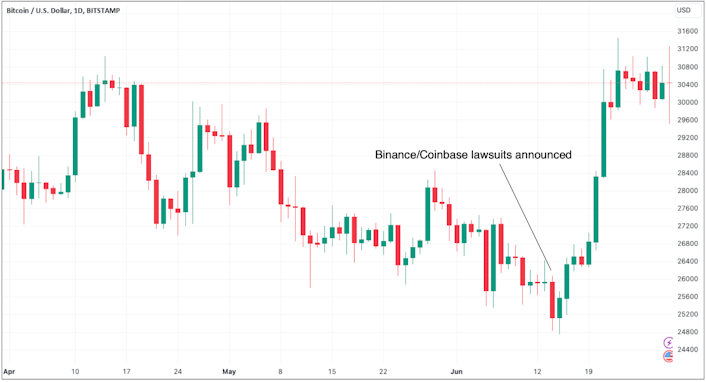
There are plenty of reasons Bitcoin may have shrugged off this negative news. For starters, one common sign of the beginning of any bull run is when the market disregards seemingly bad news. When bad news no longer negatively impacts the price, this shows seller exhaustion after the prolonged bear market since November 2021. This is the classic adage that early bull markets climb a “wall of worry.”
Secondly, Bitcoin’s price could be reacting to the fact that investors are starting to understand that Bitcoin is the only cryptocurrency with any regulatory clarity. Capital could flow out of riskier cryptocurrencies and into Bitcoin as investors attempt to reduce their risk.
Lastly, there has been good news recently that’s outweighing the lousy news in investors’ minds. All of these factors appear to be in play today regarding Bitcoin.
These recent legal actions against the two largest exchanges come after a year in which we saw crypto-native hedge funds, trading firms, exchanges, and lenders falter one by one. The landscape of the broader cryptocurrency industry has irrevocably changed.
Many of the dominant companies from 2022, along with their key figures, are no longer here. Some have filed for bankruptcy, some are mired in regulatory troubles, and others are awaiting trials for their alleged crimes.
While some may interpret these events as signs that, once again, “Bitcoin is dead, ” larger entities seem to see this as an opportunity to gain market share in this emerging asset class.
Sign up to start saving Bitcoin
Buy automatically every day, week, or month, starting with as little as $10.
Since the announcement of these lawsuits, there’s been a surge of declarations from traditional financial firms expressing their intention to enter the Bitcoin market in some capacity after years of sitting on the sidelines.
After many years of these firms avoiding Bitcoin and even actively discouraging investors from investing in it, they seem to have finally woken up to Bitcoin’s innovation.
Let’s look at how the messaging from these financial institutions has changed over the years.
Then:

Bitcoiner Niko Jilch had a chance to interview Fink in Austria on June 13th, 2018, and asked him about his Bitcoin views. Here is what he said…
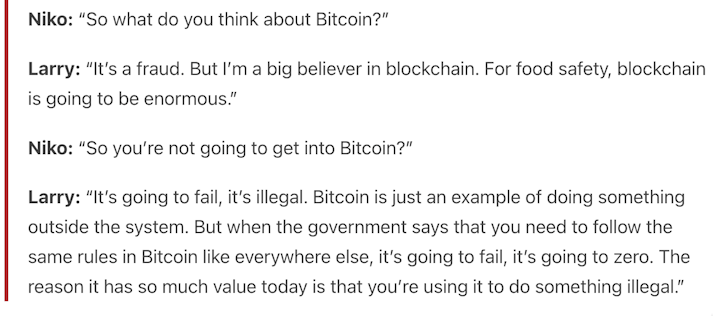
Now:
In December 2020, Larry Fink began to change his tune with Bitcoin. In an interview, he stated, “Can it [Bitcoin] evolve into a global market?
Possibly. Indeed, to me, the evidence that it has captured the imagination of so many who want to learn about it or are interested in it is a very telling sign.”
This quote foreshadowed what was to come.
In the Summer of 2022, BlackRock announced that it would connect its Aladdin investment platform to Coinbase Prime to provide its clients with access to crypto trading and custody services.
A week later, BlackRock launched a spot Bitcoin trust for its private clients.

Fast forward to this past month, and BlackRock has filed for a Spot Bitcoin ETF. (more on this later)

Then:
Over the years, Deutsche Bank has consistently warned its clients of the risks of investing in Bitcoin, even going as far as telling investors to avoid it altogether. In 2020, they warned that an economic crisis could lead to the “end of Bitcoin.”
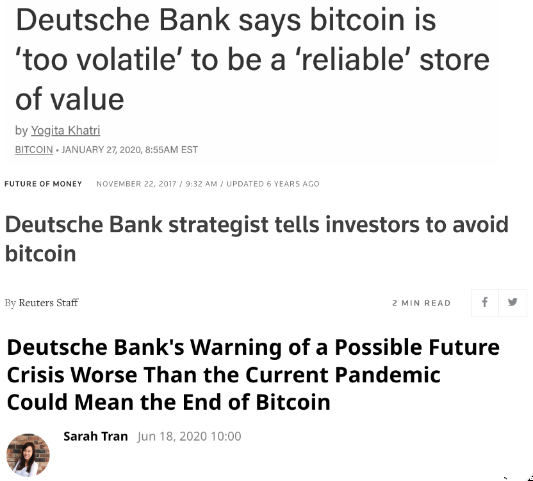
Now:
In 2021, the bank stated that it was exploring the possibility of offering an “institutional-grade hot/cold storage solution with insurance-grade protection.” It appears now those plans are being set into motion.
Last week, Deutsche Bank applied for a digital asset license from German regulator BaFin to operate as a crypto custodian to drive the bank’s growth.
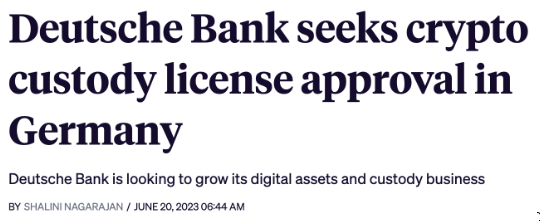
German’s largest bank has apparently had a change of heart. It is now taking action to develop its infrastructure and get into the Bitcoin game.
Then:
In the past, Santander had terminated client accounts for trading Bitcoin and limited clients from sending Bitcoin payments.

“Santander Bank, the $90 billion Spanish financial institution and banking group, recently began to close accounts of users involved with Bitcoin trading.”
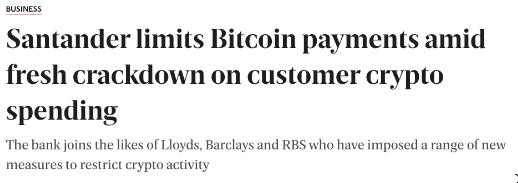
Now:
Santander is taking steps to provide its clients access to Bitcoin. CACEIS, the asset servicing arm of the bank, became registered by France’s Financial Markets Authority (AMF) as a crypto custodian.

On top of that, Santander even published its own research on the Lightning Network.

Santander is not only building out infrastructure but is also educating its clients on the innovation occurring on Bitcoin. Oh, how the tides have changed.
Then:
The CEO of Citadel, one of the largest hedge funds in the world, Ken Griffin, has often slandered Bitcoin in the past, calling it a Tulip bubble and a “Jihadist call” against the dollar.
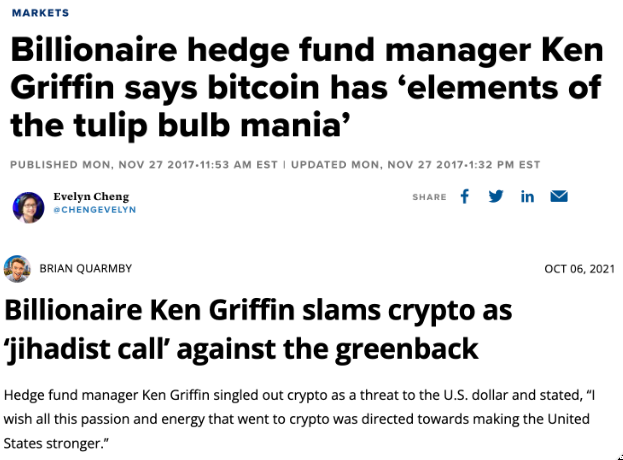
Now:
Not even a year after criticizing Bitcoin, in a Bloomberg interview, Ken Griffin admitted that he was wrong about it.

Griffin stated, “Crypto has been one of the great stories in finance over the last 15 years. And I’ll be clear, I’ve been in the naysayer camp over that period.”
I still have my skepticism, but hundreds and millions of people today disagree with that,” he said.
“To the extent that we’re trying to help institutions and investors solve their portfolio allocation problems, we have to seriously consider being a market maker in crypto.”
Griffin appeared to be preparing the market for the idea that Citadel would soon be dipping its feet into Bitcoin. This culminated in Citadel teaming up with other financial giants like Charles Schwab and Fidelity to build a new exchange called EDX Markets.
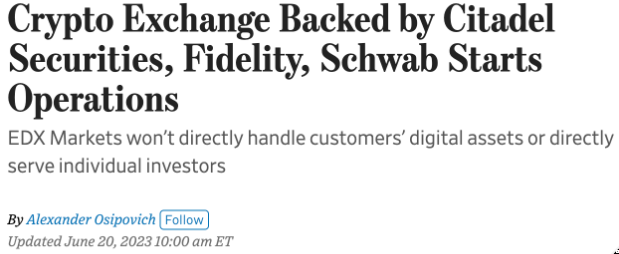
EDX Markets recently went live and stated that it draws on “standard practices in traditional, regulated financial markets and differs in key ways from how crypto exchanges typically operate.” The main difference is EDX Markets solely operates as an exchange. Unlike crypto exchanges like FTX, they plan to separate the functions of exchange, custody, and clearing to prevent conflicts of interest. In many ways, the adults are coming into the room.
Then:
France’s second-largest bank, Societe Generale, was no different than its counterparts in doubting Bitcoin in the past. Its CEO publicly stated that Bitcoin had no future in 2017. In 2021, it declared that gold is better than Bitcoin in a portfolio.
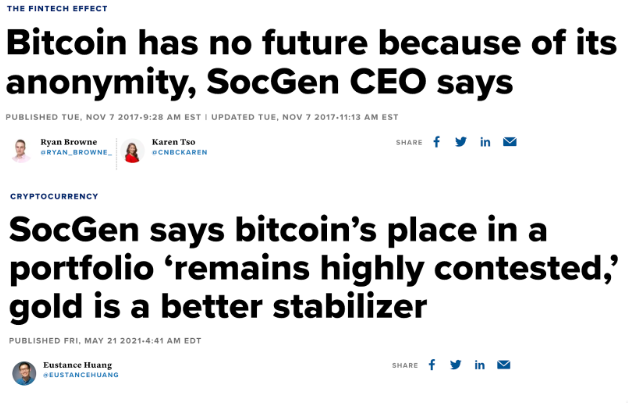
Now:
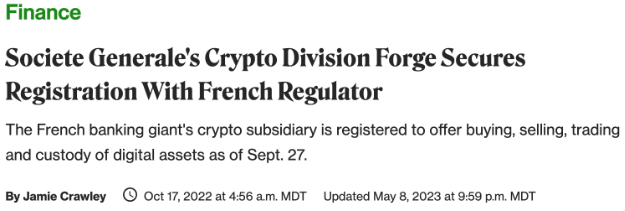
SocGen has now secured registration to become a crypto custodian after receiving licensing approval from France’s Financial Markets Authority (AMF). The French bank doesn’t want to be left behind.
Two entities that we haven’t mentioned yet are Fidelity ($4.2 trillion AUM) and Charles Schwab ($7 trillion AUM). The reason is that both have been more supportive of Bitcoin. Charles Schwab has always taken a “wait and see” approach and, to my knowledge, has never slandered it publicly. Fidelity has been a leader in the industry.
It has been building Bitcoin infrastructure and publicly endorsing Bitcoin since around 2014. Both of these firms are also behind the EDX Markets exchange mentioned above.
These all indicate a large shift in sentiment towards Bitcoin within these large financial institutions. These incumbent players appear to be finally recognizing the massive opportunity that exists by supporting Bitcoin to make money for their shareholders.
These banks are capitulating and are starting to understand that Bitcoin has staying power and that they better be prepared for its adoption to continue to grow.
These recent developments have prompted some speculation among Bitcoiners regarding the sequence of events and the timing of these announcements amidst the regulatory crackdown on crypto-native exchanges.
Preston Pysh captured this attitude in his tweet below.
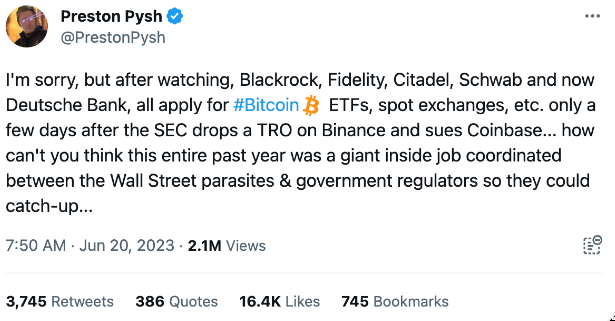
Whether or not this was a concerted effort between traditional banks and regulators to squash crypto-native firms for their own gain is pure speculation.
Still, regardless, when it comes to Bitcoin’s price and overall adoption, these are bullish developments.
The combined AUM of the traditional financial institutions mentioned above equates to $24.9 trillion. With a market capitalization of ~$592 billion today, Bitcoin’s market cap exceeds the AUM of only one of the companies mentioned above (Citadel). Bitcoin is a tiny asset, especially compared to other traditional asset classes, with an absolute fixed supply.
So what will happen when all of this institutional demand for Bitcoin occurs all at once?
I’ll give you a hint…
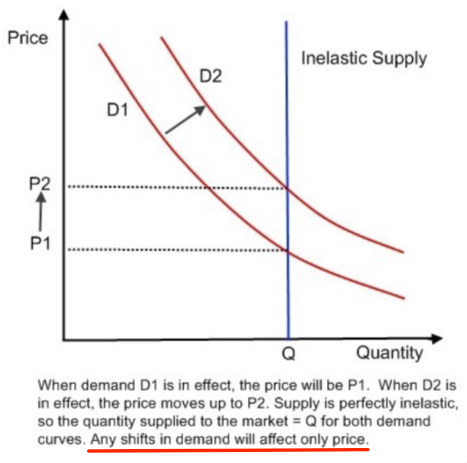
BlackRock Throws Its Hat in the Ring
Out of all of these bullish news headlines, none was larger than the announcement that BlackRock, the largest asset manager in the world, with over $9 trillion in assets under management, has filed for a spot Bitcoin ETF. Once this announcement occurred, all of the other ones soon followed.
Over the last decade, a spot Bitcoin ETF has been a topic of lore for Bitcoiners. A spot Bitcoin ETF has always been “right around the corner,” only for the SEC to reject every application. To date, there have been nearly 30 spot ETF applications that have been rejected by the SEC. The reasons why the SEC has rejected these ETFs have primarily revolved around the lack of investor protections and the risk of market manipulation of the spot markets. But many view this application as having a good probability of getting approved.
Why?
1. This is BlackRock. Whereas past ETF applications have primarily come from crypto-native firms, this filing has been made by arguably the world’s most powerful and largest asset manager. BlackRock doesn’t file for ETFs if they don’t think they have a good chance of approval. Its successful track record of ETF filings says it all — BlackRock has been approved 575 times and has only been rejected once.
2. The most significant difference between this application and those in the past is that it addresses the SEC’s main argument for rejecting prior spot ETF filings: a lack of comprehensive surveillance-sharing agreement to prevent market manipulation and fraud.
Fidelity lays out this fact in its ETF re-filing:

Fidelity ETF Filing
When the SEC approved a CME Bitcoin Futures ETF, its argument was,
“The CME ‘comprehensively surveils futures market conditions and price movements on a real-time and ongoing basis to detect and prevent price distortions, including price distortions caused by manipulative efforts.”
Thus, the CME’s surveillance can reasonably be relied upon to capture the effects on the CME Bitcoin futures market caused by a person attempting to manipulate the proposed futures ETP by manipulating the price of CME Bitcoin futures contracts, whether that attempt is made by directly trading on the CME Bitcoin futures market or indirectly by trading outside of the CME Bitcoin futures market.” — Tencium Futures ETF Approval
BlackRock and other firms argue that if the Bitcoin Futures pricing is based on the pricing of the underlying spot Bitcoin markets, why wouldn’t the CME satisfy the SEC’s concerns for a spot Bitcoin ETF as well?
This is exactly what Grayscale is arguing in its ongoing lawsuit against the SEC to convert its Grayscale Bitcoin Trust into a spot Bitcoin ETF. Grayscale contends that the SEC is acting arbitrarily and capriciously by approving a Bitcoin Futures ETF while not approving a Bitcoin Spot ETF.
This stance appears to contradict the Administrative Procedure Act and the Exchange Act’s requirement for rules and regulations to be applied without favoritism for one type of product over another. The Bitcoin Futures ETF trades on the CME. However, it is priced using the same pricing indices that reference the same underlying spot markets. Therefore, both products are exposed to the same risks, making the approval of one product over another seemingly unfair.
This is a strong argument for why a spot ETF should be approved, which is why Bloomberg’s Senior Legal Analyst Elliot Stein gives Grayscale a 70% chance of winning its case against the SEC. Is BlackRock potentially front-running a Grayscale win?
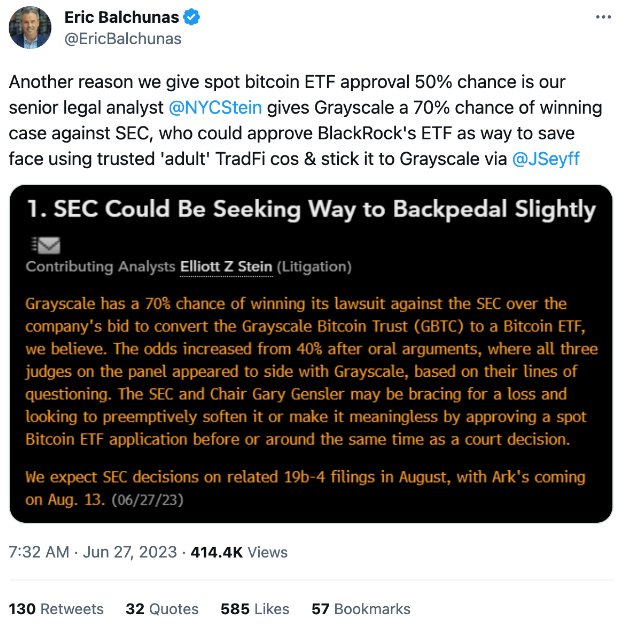
But BlackRock even went a step further than every other ETF application to date. It’s also establishing a surveillance-sharing agreement with Nasdaq and “U.S. BTC Spot Market Platform” (presumably Coinbase) to add an additional layer of protection for investors to quell the SEC’s concerns.
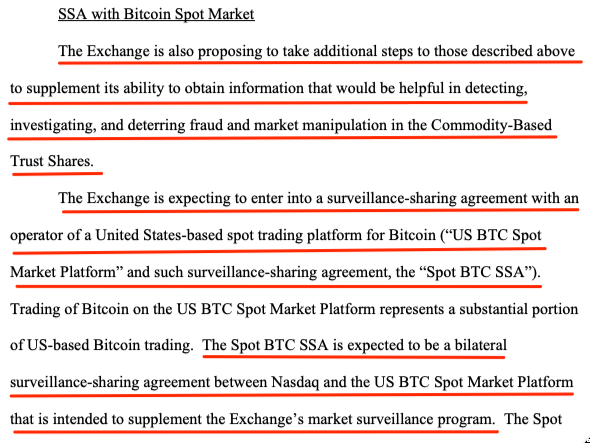
Blackrock ETF Filing
This detail is why many market participants are optimistic that BlackRock’s ETF application will get approved. They believe this addresses the SEC’s longstanding concerns regarding having proper surveillance and controls in place to identify fraud and manipulation in the spot markets.
Not long after BlackRock’s ETF, we saw investment firm ARK amend its ETF filing to include a similar surveillance-sharing agreement. This was notable because it shows that ARK thought this was important enough to amend its filing to improve its approval chances. This is also important because ARK has filed before BlackRock, meaning that it could be the first ETF approved, not BlackRock.
Next came Fidelity re-filing its ETF application, this time with a similar surveillance sharing agreement between a “US BTC Spot Market Platform” (presumably Coinbase) and the CBOE.
We also saw WisdomTree ($87 billion AUM) and Invesco ($1.5 trillion AUM) file ETF applications of their own. In other words, the race is on.
The SEC wasted no time in responding to these new ETF applications. It has returned the filings because it didn’t specifically name the spot Bitcoin exchange with which they are expected to have a “surveillance-sharing agreement” or provide enough details about those arrangements. These firms will need to provide more information before the SEC even considers approving their applications.
What could happen to the price of Bitcoin if the vaunted spot ETF gets approved?
Well, the nice thing is we have already seen how the market would react to a spot Bitcoin ETF given that The Purpose Bitcoin ETF out of the Toronto Stock Exchange launched in February 2021. If this foreshadowed what was to come, we could be in for fireworks.
When the Purpose Bitcoin ETF first launched, it broke records. It traded $80 million worth of shares in its first hour and $200 million in its first day. It went on to eclipse over $1 billion in AUM after only 3 months after being listed.
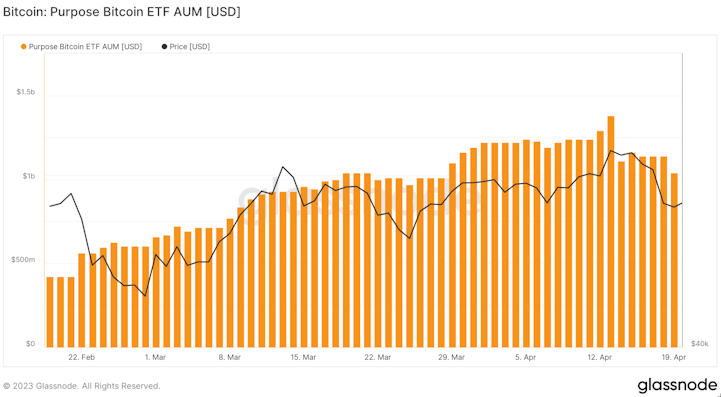
A U.S.-based ETF would almost surely be even more popular than its Canadian counterpart. A spot Bitcoin ETF would attract so much demand because it fits into the existing regulatory structure for institutional investors like financial advisors, family offices, pension funds, etc.
A Bitcoin ETF would allow these investors to gain exposure to Bitcoin through an investment product they are familiar with and approved by their investment mandates. If they have been sitting on the sidelines because regulations have been preventing them from owning spot Bitcoin or because they didn’t feel technically capable of acquiring it, then an ETF is going to be very attractive to these institutional players.
However, all of this news comes with one large caveat — a spot ETF is not real Bitcoin. By buying an ETF, an investor buys a paper IOU that represents the underlying Bitcoin; they don’t own it. All of these potential ETFs come with counterparty risk. Under most of these trust agreements, shareholders generally have no voting rights or rights to authorize actions in the trust. You are trusting the sponsor to secure and manage Bitcoin effectively.
Furthermore, these ETFs carry fees that an investor shouldn’t incur when buying actual bitcoin. So, while this may be bullish for the price of Bitcoin, nothing can top buying real Bitcoin — with no counterparty risk — that you own.
Financial institutions are coming to Bitcoin. And what they will eventually realize is that Bitcoin is an extremely scarce asset. There will only ever be 21 million. Retail investors who understand this have been front-running these institutions for years, slowly accumulating the only asset in the world with an absolute fixed supply. For once, the big financial institutions are late to the game, and it’s beautiful to see.
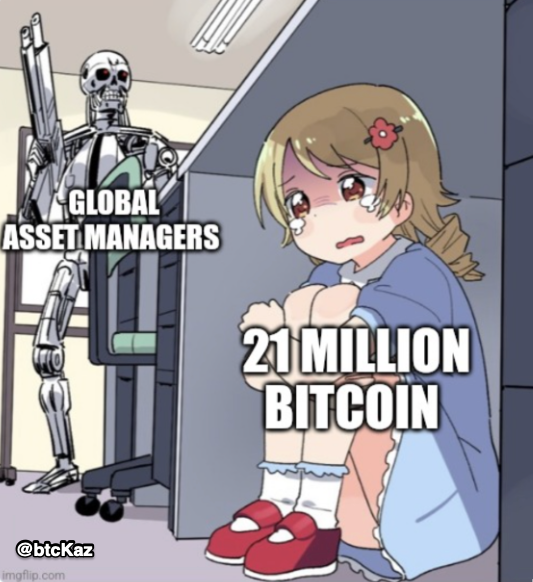
Market Overview
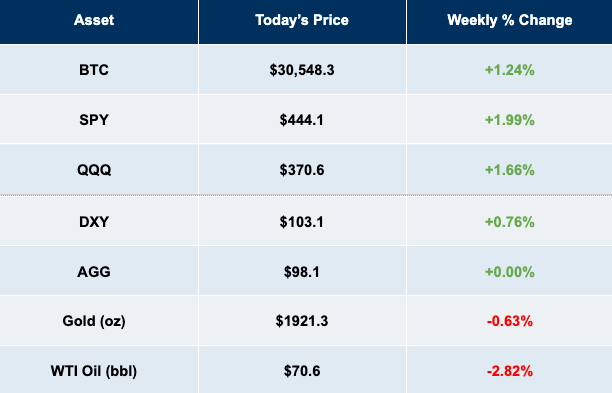
Tradingview, Prices as of 06/30/23
Sign up to start saving Bitcoin
Buy automatically every day, week, or month, starting with as little as $10.
Sam Callahan is the Lead Analyst at Swan Bitcoin. He graduated from Indiana University with degrees in Biology and Physics before turning his attention towards the markets. He writes the popular “Running the Numbers” section in the monthly Swan Private Insight Report. Sam’s analysis is frequently shared across social media, and he’s been a guest on popular podcasts such as The Investor’s Podcast and the Stephan Livera Podcast.
More from Swan Signal Blog
Thoughts on Bitcoin from the Swan team and friends.


MSTR vs. GBTC Compared: Which is Best in 2024?

By Drew
This article compares MSTR and GBTC, offering insights for investors by examining their features, benefits, performance, fees, and drawbacks, focusing on their role in Bitcoin investment strategies.


Changing Bitcoin: The Past, The Present, and The Future (Part One)

By Tomer Strolight
For Bitcoin to achieve the lofty goals many have for it, its rules will need to change. This three-part series of articles will tackle what it takes to change Bitcoin.


4 Reasons to Avoid Coinbase In 2024?

By Matt Ruby
The crypto platform is facing all kinds of problems. Is it time for customers to seek out an alternative?